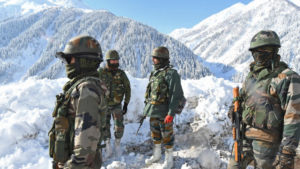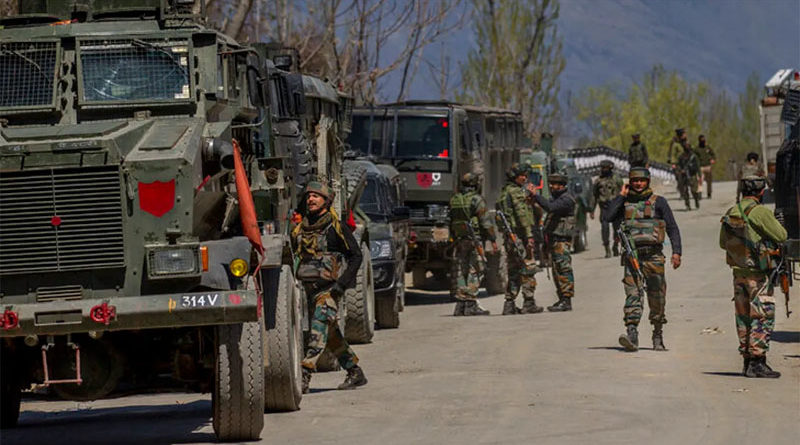India Shifts 50,000 Troops To China Border In Historic Move
Jun 28 2021
India now has roughly 200,000 troops focused on the border, up more than 40 per cent from last year The countries battled in 1962, India’s strategic focus has primarily been Pakistan since the British left.
India has redirected at least 50,000 additional troops to its border with China in a historic shift toward an offensive military posture against the world’s second-biggest economy.
Although the two countries battled in the Himalayas in 1962, India’s strategic focus has primarily been Pakistan since the British left the subcontinent, with the long-time rivals fighting three wars over the disputed region of Kashmir.
Yet since the deadliest India-China fighting in decades last year, Prime Minister Narendra Modi’s administration has sought to ease tensions with Islamabad and concentrate primarily on countering Beijing.

Over the past few months, India has moved troops and fighter jet squadrons to three distinct areas along its border with China, according to four people familiar with the matter. All in all, India now has roughly 200,000 troops focused on the border, two of them said, which is an increase of more than 40 per cent from last year.
Both the Indian Army and a spokesman for the Prime Minister’s Office in New Delhi didn’t respond to requests for comment.
Whereas previously India’s military presence was aimed at blocking Chinese moves, the redeployment will allow Indian commanders more options to attack and seize territory in China if necessary in a strategy known as “offensive defense,” one of the people said. That includes a lighter footprint involving more helicopters to airlift soldiers from valley to valley along with artillery pieces like the M777 howitzer built by BAE Systems Inc.
While it’s unclear how many troops China has on the border, India detected that the People’s Liberation Army recently moved additional forces from Tibet to the Xinjiang Military Command, which is responsible for patrolling disputed areas along the Himalayas.
China is adding fresh runway buildings, bomb-proof bunkers to house fighter jets and new airfields along the disputed border in Tibet, two of the people said. Beijing also adding long-range artillery, tanks, rocket regiments and twin-engine fighters in the last few months, they said.
China’s Foreign Ministry “will not comment on unsubstantiated information,” a spokesperson said in response to questions.
The fear now is that a miscalculation could lead to an even deadlier conflict. Several recent rounds of military-diplomatic talks with China have made minimal progress toward a return to the quiet status quo that had prevailed along the border for decades.
“Having so many soldiers on either side is risky when border management protocols have broken down,” said D S Hooda, a lieutenant general and former Northern Army commander in India. “Both sides are likely to patrol the disputed border aggressively. A small local incident could spiral out of control with unintended consequences.”
The northern region of Ladakh — where India and China clashed several times last year — has seen the largest increase in troop levels, three of the people said, with an estimated 20,000 soldiers including those once engaged in anti-terrorism operations against Pakistan deployed in the area. The reorientation means India at all times will have more troops acclimatized to fight in the high-altitude Himalayans, while the number of troops solely earmarked for the western border with Pakistan will be reduced.
India has also obtained an offensive capability along the southern Tibetan plateau near the center of the border. In that more populated area, regular soldiers outfitted with machine guns have joined lightly armed paramilitary officers, the people said.
In the far eastern state of Arunachal Pradesh, where most of India’s border forces had been located and where much of the 1962 India-China war played out, newly acquired French-made Rafale fighter jets armed with long-range missiles are being deployed to support the boots on the ground, the people said. includes a lighter footprint involving more helicopters to airlift soldiers from valley to valley along with artillery pieces like the M777howitzer built by BAE Systems Inc.
While it’s unclear how many troops China has on the border, India detected that the People’s Liberation Army recently moved additional forces from Tibet to the Xinjiang Military Command, which is responsible for patrolling disputed areas along the Himalayas.
China is adding fresh runway buildings, bomb-proof bunkers to house fighter jets and new airfields along the disputed border in Tibet, two of the people said. Beijing also adding long-range artillery, tanks, rocket regiments and twin-engine fighters in the last few months, they said.
China’s Foreign Ministry “will not comment on unsubstantiated information,” a spokesperson said in response to questions. The fear now is that a miscalculation could lead to an even deadlier conflict. Several recent rounds of military-diplomatic talks with China have made minimal progress toward a return to the quiet status quo that had prevailed along the border for decades.
“Having so many soldiers on either side is risky when border management protocols have broken down,” said D S Hooda, a lieutenant general and former Northern Army commander in India. “Both sides are likely to patrol the disputed border aggressively. A small local incident could spiral out of control with unintended consequences.”
The northern region of Ladakh — where India and China clashed several times last year — has seen the largest increase in troop levels, three of the people said, with an estimated 20,000 soldiers including those once engaged in anti-terrorism operations against Pakistan now deployed in the area. The reorientation means India at all times will have more troops acclimatized to fight in the high-altitude Himalayans, while the number of troops solely earmarked for the western border with Pakistan will be reduced.
India has also obtained an offensive capability along the southern Tibetan plateau near the center of the border. In that more populated area, regular soldiers outfitted with machine guns have joined lightly armed paramilitary officers, the people said.
In the far eastern state of Arunachal Pradesh, where most of India’s border forces had been located and where much of the 1962 India-China war played out, newly acquired French-made Rafale fighter jets armed with long-range missiles are being deployed to support the boots on the ground, the people said.
Courtesy: ET

